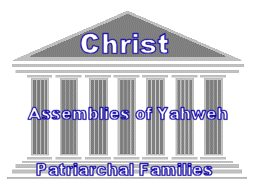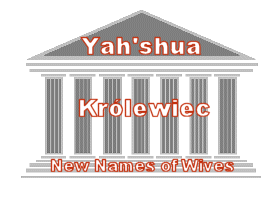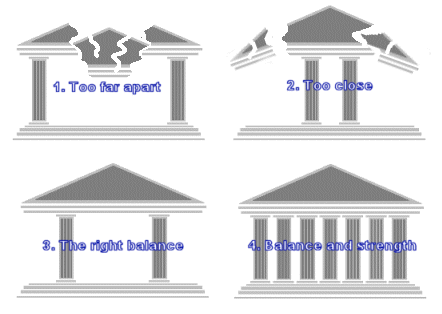"He who overcomes, I will make him a pillar in the temple of My Elohim (God), and he shall go out no more. And I will write on him the name of My Elohim (God) and the name of the city of My Elohim (God), the New Jerusalem, which comes down out of heaven from My Elohim (God). And I will write on him My new name" (Revelation 3:12-13, NKJV)
What a picture this is! Each and every redeemed soul in Christ becomes a spiritual pillar in the Temple of Yahweh, the redeemed Body of Christ. And upon each spiritual pillar are a number of key inscriptions:
- 1. The Name of Yahweh, our Heavenly Father, in which Name he has laboured, fought and at times suffered;
- 2. The Name of the City of Yahweh, the New Jerusalem, which is not the the earthbound Church of God or Assembly of Yahweh, but the heavenly one consisting of all the redeemed in the Messiah, and upon this same pillar will be recorded all our services for that Church/Assembly which we did whilst here; and
- 3. The New Name of Christ, under whose banner we have served, and through whom we became overcomers.
To understand the meaning of the symbolism herein used we must understand the two-fold purpose of pillars biblically. As we have seen, pillars frequently served as monuments. Rachel's grave was so marked by Jacob (Genesis 35:20) and Absalom, who was childless, set up a pillar to which he gave his own name as his own memorial (2 Samuel 18:18). The name conferred on the stone identified it with the bearer of that name. Thus the pillar represents a whole person, and the name identifies that person.
But there is more to sacred pillars than this. Jacob, we will remember, also set up stone slabs as memorials of the theophanies (appearances of Yahweh) that he experienced, and it was common to anoint these stones with oil, which of course, symbolised the Holy Spirit. Each of these stones or pillars Jacob named House of Elohim (God) (from the Hebrew, bęt'él) to indicate their significance to him (Genesis 28:18-22; 35:13-15). Pillars were also used to signify covenants as between Jacob and Laban, and between Yahweh and Israel (Genesis 31:45-54; Exodus 24:4; Joshua 24:26-27). The same was done when the Jordan was crossed (Joshua 4:1-9) and after the victory over the Philistines at Mizpah (1 Samuel 7:12) where they are called Eben ha'ezer or 'Stones of Help'. This then is the significance of the victorious Christian/Messianic who will be a pillar in the Temple of Elohim (God), bearing the Names of Yahweh, the New Jerusalem, and the new Name of the Son of Man.
But the pillar here is more than simply a memorial stone in a temple -- it is also one of its supporting structures. As fellow believers, we are meant to support one another in Christ, bearing each other's burdens as well as sharing in each other's joys. The pillar is therefore a reminder to us that there is no such thing as a solo-Christian or a solo-Patriarch, but that we are all inter-connected in one spiritual family. And the chief pillars are the leaders in the local assemblies/churches, and the three chief apostles over the whole Assembly of Yahweh/Church of God, a term also used of those generally who support an institution (Galatians 2:9).
The Family of Christ is, of course, enormous. Down here on earth we can never come to know more than the smallest part. And the two parts which we are supposed to come and know the best are the local church/assembly and our families of which it is itself built up.
 Now as we all know, a polygamous marriage in Christ is a miniature representation of the Temple of Yahweh-Elohim. The local church/assembly is a spiritual union of such families together with monogamous families (see diagram opposite); and all the local churches/assemblies form one Assembly of Yahweh or Church of God. In the opening chapters of the Book of Revelation, seven congregations in Asia Minor are singled our as being representative of the seven overcomings of the Church of God/Assembly of Yahweh in all ages, which are required of those who wish themselves to be pillars in the Temple of Yahweh.
Now as we all know, a polygamous marriage in Christ is a miniature representation of the Temple of Yahweh-Elohim. The local church/assembly is a spiritual union of such families together with monogamous families (see diagram opposite); and all the local churches/assemblies form one Assembly of Yahweh or Church of God. In the opening chapters of the Book of Revelation, seven congregations in Asia Minor are singled our as being representative of the seven overcomings of the Church of God/Assembly of Yahweh in all ages, which are required of those who wish themselves to be pillars in the Temple of Yahweh.
As we have seen, every member of the Assembly/Church/Temple of Yahweh requires three names - the Name of Elohim (God = Yahweh), the Name of the Holy City (New Jerusalem), and the New Name of the Messiah, Yah'shua (Jesus). In the same way, every patriarchal family pillar consists of:

- 1. The Name of Christ, who is the Head;
- 2. The Name of the Patriarch, which is the Family Name; and
- 3. Each New Name of his wives.
All my wives bear my name in theirs as either a family name (Królewiec, the Western tradition) or my first name (Stan, the biblical pattern). I also give each of my wives a spiritual name, which is their new name upon being grafted back into me as their 'Adam'. And of course, together as a unit we bear the Name of Yah'shua the Messiah (Jesus Christ). They are the pillars of honour in my spiritual temple, which is Christ's temple, and together with all the other patriarchal family temples constitutes the Temple of the New Jerusalem.
Why is Christ given a new Name? Because He is, spiritually-speaking, the sum total of His allegorical brides. He changes, just as husbands change as a new wife is grafted back in to him.
As I am sure everyone knows, the positioning of pillars is essential to the sound structure of any building which employs them. If they are too far apart (1), the building will cave in in the middle. If they are too close (2), the building will collapse on the extremities. But if they are correctly positioned (3), there is a proper balance of forces which confers stability. And the more pillars that are added (4), the more solid and secure the building becomes (see diagram below).

Adjusting the position of a new pillar (wife) takes time as she finds her place in the family, just as a new convert takes time finding his place in the local assembly/church. This is a very delicate operation. Wrong positioning - accidental or deliberate - causes instabilities and therefore disturbance and possible suffering to the whole. In echad polygamy there is a 'place' for all the wives requiring careful juxtapositioning in that invisible temple which is the inner, spiritual world. Most of this occurs naturally, effected by the Holy Spirit as one is true to covenants and the commandments, remaining in a contrite, humble and repentant spirit as is the basic requirement of all believers, and resisting the carnal nature until it is crucified in Christ. The assembly of the Echad Family is very much along the same lines as the assembly of the invisible Body of Christ, the requirements for harmony and success being no different.
Author: SBSK















































